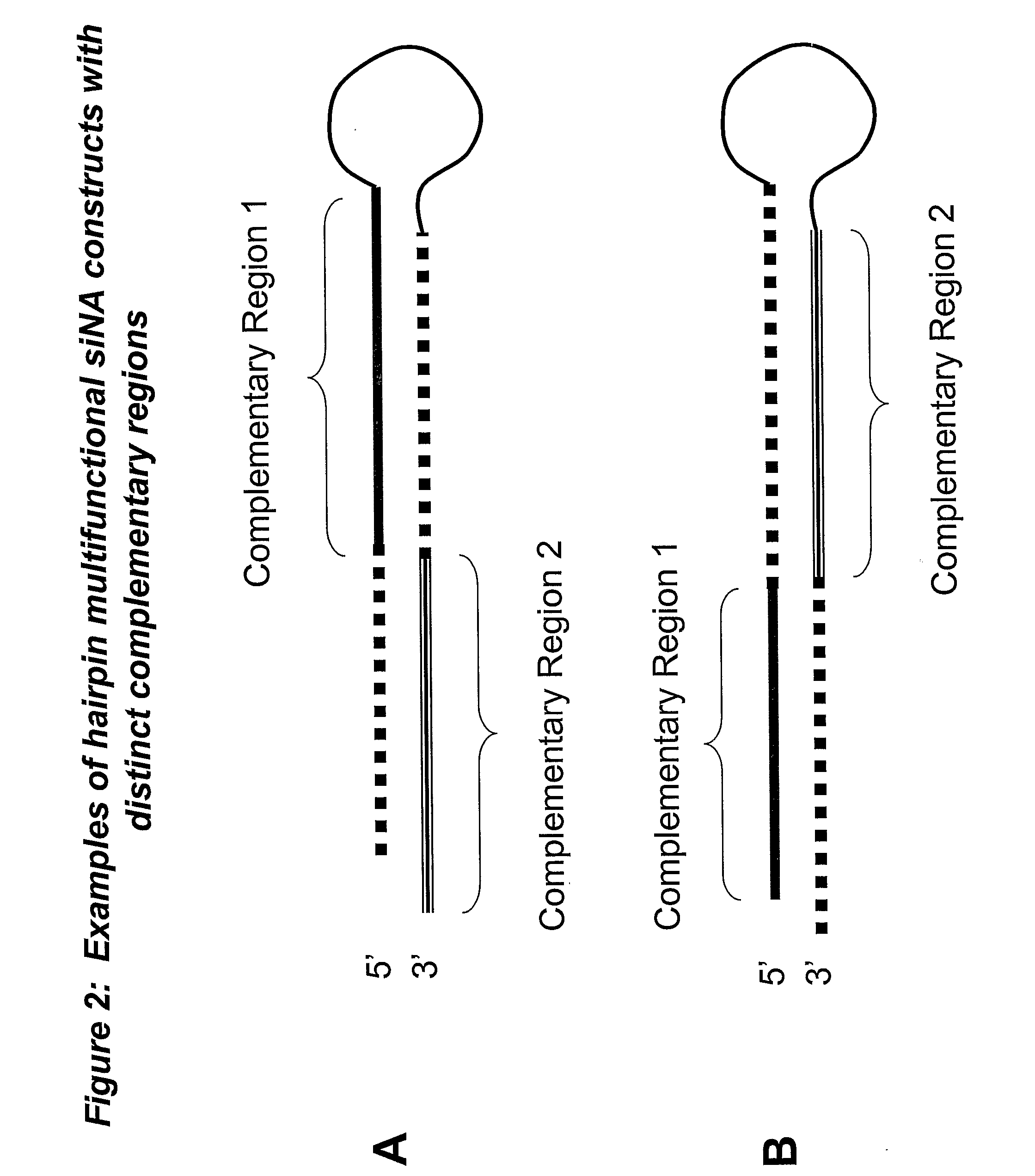Rna Interference Mediated Inhibition of Gene Expression Using Multifunctional Short Interfering Nucleic Acid (Multifunctional Sina)
a technology of rna interference and nucleic acid, which is applied in the direction of peptide/protein ingredients, drug compositions, organic chemistry, etc., can solve the problems of non-specificity and non-predictability of off-targets that are affected by dsrnas, and achieve the effects of improving the bioavailability and/or potency of nucleic acid molecules, facilitating nucleic acid molecules to be targeted, and enhancing half-li
- Summary
- Abstract
- Description
- Claims
- Application Information
AI Technical Summary
Benefits of technology
Problems solved by technology
Method used
Image
Examples
example 1
Serum Stability of Chemically Modified siNA Constructs
[0308] Chemical modifications are introduced into siNA constructs to determine the stability of these constructs compared to native siNA oligonucleotides (or those containing for example two thymidine nucleotide overhangs) in human serum. RNAi stability tests are performed by internally labeling siNA and duplexing by incubating in appropriate buffers to facilitate the formation of duplexes by the siNA. Duplexed siNA constructs are then tested for stability by incubating at a final concentration of 2 μM siNA (strand 2 concentration) in 90% mouse or human serum for time-points of 30 sec, 1 min, 5 min, 30 min, 90 min, 4 hrs 10 min, 16 hrs 24 min, and 49 hrs. Time points are run on a 15% denaturing polyacrylamide gels and analyzed on a phosphoimager.
[0309] Internal labeling is performed via kinase reactions with polynucleotide kinase (PNK) and 32P-γ-ATP, with addition of radiolabeled phosphate at a nucleotide position (e.g. nucleot...
example 2
Identification of Potential siNA Target Sites in any RNA Sequence
[0310] The sequence of an RNA target of interest, such as a viral or human mRNA transcript, is screened for target sites, for example by using a computer folding algorithm. Such target sites can contain complementary, palindrome or repeat sequences that are shared by more than one target nucleic acid sequence such that multifunctional siNA molecules can be designed to target differing nucleic acid sequences sharing common palindrome or repeat sequences or having some degree of self complementarity. In addition, the use of non-naturally occurring nucleotides or non-nucleotides can be utilized to generate artificial complementary, palindrome, or repeat regions within a multifunctional siNA molecule of the invention (see for example FIG. 7). In a non-limiting example, the sequence of a gene or RNA gene transcript derived from a database, such as Genbank, is used to generate siNA sequences having complementarity to the ta...
example 3
Selection of siNA Molecule Target Sites in a RNA
[0317] The following non-limiting steps can be used to carry out the selection of siNAs targeting a given gene sequence or transcript.
[0318] The target sequence is parsed in silico into a list of all fragments or subsequences of a particular length, for example 23 nucleotide fragments, contained within the target sequence. This step is typically carried out using a custom Perl script, but commercial sequence analysis programs such as Oligo, MacVector, or the GCG Wisconsin Package can be employed as well.
[0319] In some instances, the siNAs correspond to more than one target sequence; such would be the case for example in targeting different transcripts of the same gene, targeting different transcripts of more than one gene, or for targeting both the human gene and an animal homolog. In this case, a subsequence list of a particular length is generated for each of the targets, and then the lists are compared to find matching sequences ...
PUM
| Property | Measurement | Unit |
|---|---|---|
| Volume | aaaaa | aaaaa |
| Volume | aaaaa | aaaaa |
| Volume | aaaaa | aaaaa |
Abstract
Description
Claims
Application Information
 Login to View More
Login to View More - R&D
- Intellectual Property
- Life Sciences
- Materials
- Tech Scout
- Unparalleled Data Quality
- Higher Quality Content
- 60% Fewer Hallucinations
Browse by: Latest US Patents, China's latest patents, Technical Efficacy Thesaurus, Application Domain, Technology Topic, Popular Technical Reports.
© 2025 PatSnap. All rights reserved.Legal|Privacy policy|Modern Slavery Act Transparency Statement|Sitemap|About US| Contact US: help@patsnap.com



